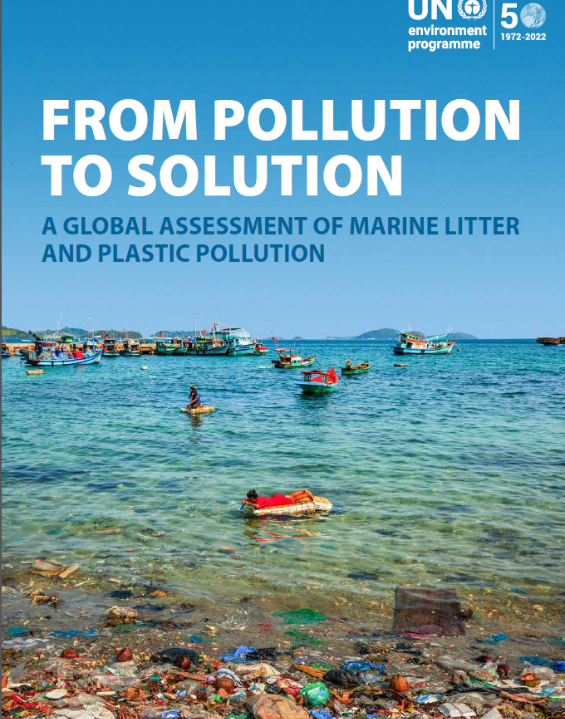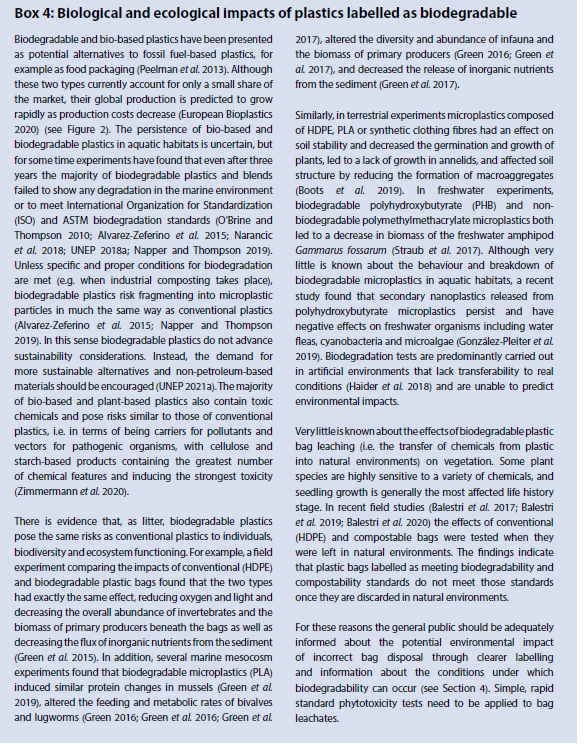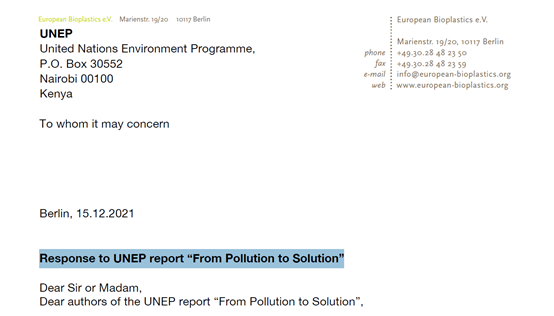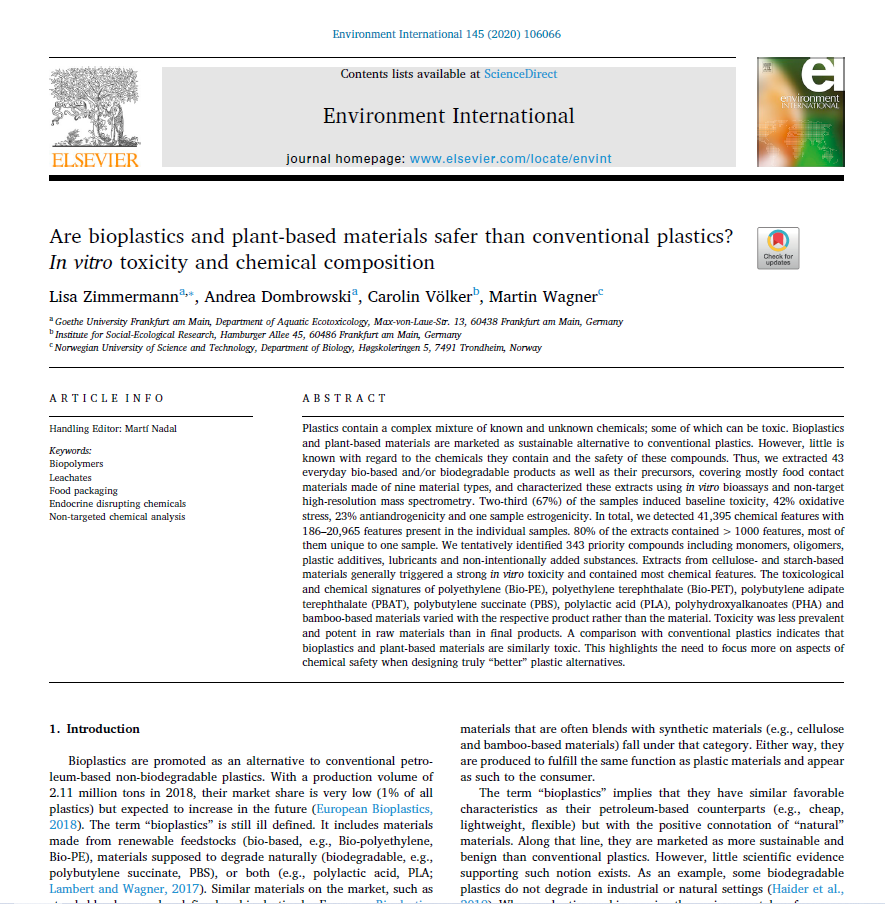Welcome to MintBio Huitong New Materials (Yangzhou) Co., Ltd website!
Public Letter on Industry Associations' Comments on the United Nations Environment Programme�
Time:2021-12-18 09:10:04 Visits:339
In October 2021, the United Nations Environment Programme released a global report(From Pollution to Solution: a global assessment of marinelitter and plastic pollution)However, some comments on biodegradable plastics and bio based plastics in this report may have issues with insufficient perspective and comprehensiveness, which has caused some controversy.
 |  |
On December 15, 2021, the European Bioplastic Association (EUBP) issued an open letter to the public commenting on the report "From Pollution to Solutions: Global Assessment of Marine Garbage and Plastic Pollution" published by the United Nations Environment Programme worldwide.

EUBP first welcomes the long-term efforts of the Environment Agency in promoting economic transformation towards low-carbon, resource efficient, and environmental risk reduction. However, EUBP stated that although bioplastics have many benefits in helping to reduce, reuse, and recycle waste, misunderstandings and biases still exist regarding bioplastics, biodegradable, and compostable plastics, as stated in the recent scientific assessment by the United Nations Environment Programme titled "From Pollution to Solutions - Global Marine Garbage and Plastic Pollution Assessment" and the supplementary report titled "Submerged in Plastic - Important Charts of Marine Garbage and Plastic Waste", Both were released in early 2021. EUBP believes that both reports show insufficient understanding of the properties and characteristics of bioplastics, resulting in erroneous and highly misleading conclusions about the impact of bioplastics. These reports lack an understanding of the innovative characteristics of bioplastics and overlook recent developments, scientific evidence, and standardization work. This is inconsistent with the United Nations' commitment to reducing dependence on fossil resources, greenhouse gas emissions, and the impact of plastics on the environment.
Therefore, EUBP aims to address some of the most problematic areas identified in the report and provide a more balanced understanding of bioplastics.
(1) The definition and correct use of terms in bioplastics
Throughout the report, various terms are used to refer to the origin of bioplastics, including "bio based", "bio derived", and "plant-based", which only leads to more confusion about the meaning of bioplastics, rather than reducing it. For ordinary readers, these terms have exactly the same meaning. Unlike 'bio derived' plastics, 'bio based' plastics may be entirely fossil based (and potentially biodegradable), which is unreasonable. Therefore, EUBP strongly recommends using the most common and widely accepted definition of bioplastics: 'bioplastics are either bio based, biodegradable, or both.'. These terms are defined and clearly described in the European Standard EN 16575 developed by CEN/TC411 WG 1.
As correctly stated in the report, the term 'bioplastics' should not be used to describe specific materials without mentioning their source (based on or non biological) and their destined scrap options. Similarly, the terms "biodegradable" and "compostable" should not be used separately as general end-of-life statements, but should always be specified by the target environment (such as industrial compost, household compost, agricultural soil) for the time range and/or specific criteria for setting corresponding thresholds for biodegradation.
(2) Characteristics and advantages of bio based plastics
The two reports released by the Environment Agency completely overlook the main advantages of bio based plastics, namely removing biochar from the atmosphere, storing it in materials/products, and preventing carbon from causing climate change. This is significantly better than petrochemicals based plastics, where fossil carbon stored underground for millions of years is extracted and ultimately released into the atmosphere, which has adverse effects on the climate. Biobased products have replaced fossil carbon and reduced greenhouse gas emissions. When conducting a fair and balanced assessment of environmental impacts, this fact must be taken into account. But it was not mentioned in the report.
On the contrary, these two reports point out: "Overall, replacing a disposable product (such as plastic) with another disposable product made of different materials (such as paper, biodegradable plastic) will only transfer the environmental burden and cause other problems." (Environmental Agency, From Pollution to Solutions, p. 101).
Indeed, the priority for reducing pollution should be to reduce the quantity of disposable products to the absolutely necessary minimum, but bioplastics still have advantages over traditional plastics because they are either bio based, biodegradable (compostable), or both. In this way, although it may not completely eliminate the environmental burden, they will definitely reduce it without transferring any burden.
(3) Biodegradation behavior in different environments
To evaluate the benefits or impacts of biodegradable plastics, The report refers to the following research and conclusions: "Harrison et al. concluded in their review of the biodegradability of plastic bags that due to the shortcomings of plastic bags, current international standards and regional testing methods are not sufficient to accurately predict the impact of handheld plastic bags on wastewater, inland waters (rivers, streams, and lakes) Biodegradability in the marine environment. The existing testing procedures lack relevant standards for most unmanaged aquatic habitats, as well as broader research on the biodegradation of plastic materials under real-world conditions (Environmental Agency, "From Pollution to Solutions," p. 79). However, this reference is very problematic as it completely ignores the clear suggestion that in order to declare the biodegradability of the product, environmental conditions must be specified, and a time frame for biodegradation must be set to make the declaration measurable and comparable. This is specified in the applicable standards.
There are some specific applications, among which the characteristics of compostability and organic recycling represent ecological improvement: 1) applications that promote the collection and composting of biological waste; Easy to pollute compost; 2) And/or those that cannot or are not easily recyclable because they are: a) contaminated with food waste; b) Too small to collect, classify, and clean before recycling; c) Made of indivisible multi-layer thin films; Otherwise, it is difficult to recycle. These applications should also be made of compostable plastic, as organic recycling provides a valuable option for disposal. In situations where it is not suitable for reuse, the closed-loop system can operate well by allowing compostable packaging to be collected together with food waste. In order to be suitable for organic recycling, products and materials need to meet the strict standards of European standard EN 13432 regarding industrial compostability.
However, these reports overlook the need for these specifications, Furthermore, it was pointed out that "in recent field studies (Balestri (2017, 2019, 2020), the effects of traditional (HDPE) plastic bags and compostable plastic bags were tested. When they were left in the natural environment, the survey results showed that plastic bags labeled as meeting biodegradability and compostability standards did not meet these standards once discarded in the natural environment 。 Drawing such a conclusion is not only highly misleading, but also unconsciously promoting the idea that such products may litter. This is problematic as it can lead to the opposite result.
Due to the apparent impossibility of scientific standardization of the 'natural environment', biodegradability cannot be tested in such environments. This will never affect the added value of certifying plastic bags as industrial or household compostable. If the plastic bag meets industrial composting standards such as EN 13432, it is very suitable for collecting biological waste and composting with its contents in industrial composting facilities. Materials and applications are not designed for degradation in a "natural" environment.
The report further points out that although biodegradability may be an advantage of polylactic acid and other bio based plastics in reducing the number of landfills, few cities and communities have the infrastructure required for composting under the correct conditions. Organizations using compostable biopolymers may continue to send their waste to landfills (UNEP 2021b) 。 This may be a major issue for more commonly used bio based plastics and biodegradable plastics. (Environmental Agency, From Pollution to Solutions, p. 101)
Given the commitment to reducing waste and increasing recycling, does the above statement demonstrate the need to establish effective waste infrastructure to prevent biological waste from eventually entering landfills and releasing methane, a greenhouse gas more than 20 times stronger than carbon dioxide, rather than completely rejecting innovative solutions that offer many other benefits?
(4) Biodegradation behavior in marine environments
Biodegradability in open environments, especially in the ocean, is only applicable for very few, highly specific applications. These may be plastic waste that is difficult to find and recover, such as fireworks shells, or plastic products used by professionals (such as farmers or fishermen/fishermen) in specific situations, such as fishing lines and nets. For other applications that mainly belong to the packaging category, "biodegradability in an open environment" is neither advocated nor recognized, and the industry fully agrees that this principle should not be changed.
However, if a comprehensive assessment is to be conducted on the durability of items causing the consequences of 'littering', a risk assessment should be conducted on all materials found in an open environment.
In this regard, the report mentions the following publications: "The persistence of bio based and biodegradable plastics in aquatic habitats is still uncertain, but experiments have found that even after three years, most biodegradable plastics and mixtures have not shown any degradation in the marine environment or meet the International Organization for Standardization (ISO) and ASTM biodegradation standards, The standards mentioned in the report are all testing methods without clear pass fail criteria. Therefore, it is meaningless to say that they do not meet these standards. At the same time, some of the papers in the report failed to test certified materials or industrial compostable materials, or worse, they did not test oxidative degradation materials.
Therefore, the results of these publications cannot be used to make such general statements. On the other hand, the report did not mention that Narancic et al.'s article pointed out that several biodegradable plastics and mixtures (such as TPS, PHB, PHB-PLC mixtures, etc.) exhibit good marine biodegradability.
At present, there is no international standard that appropriately defines the biodegradation of plastics in the marine environment. However, many standardization projects are being carried out at the ISO and ASTM levels. Although biodegradable plastics may not and will never become a solution to marine waste according to established standards, they may be part of the solution. EUBP fully supports further research on the biodegradation behavior of existing material types and applications, and calls for the development of standards to measure and confirm (or reject) biodegradation claims in their respective marine environments, as biodegradable materials have already achieved this.
(5) Micro plastic risks
The advantage of biodegradable materials is that they do not erode into permanent secondary microplastics during degradation, as most natural environments contain microorganisms capable of metabolizing these polymers. Therefore, compared to traditional plastic materials, biodegradable materials have a much shorter residence time in the environment. In this way, biodegradable plastics help to minimize their impact on the environment and reduce the accumulation of plastic particles in different environmental habitats.
However, the report erroneously claims that "biodegradable plastics will not degrade into microplastic particles like traditional plastics (Napper and Thompson 2019). (Environmental Agency, From Pollution to Solutions, p. 55) This statement is not only misleading, but the research it refers to (Napper, IE and Thompson, RC (2019), Environmental Science and Technology 53 (9), 4775-4783.) contains many flaws, thus disqualifying the study. The main criticism from the academic community is that they intentionally draw general and erroneous conclusions about "biodegradable" bags from bags that claim to be biodegradable, but clearly not.
EUBP strongly recommends always carefully distinguishing between biodegradable and compostable materials. When conducting marine biodegradation tests on compostable plastics, the conclusions of these tests lack any justification. Biodegradable and compostable plastics do help reduce the risk of microplastic pollution when used in their designed applications. They are metabolized into CO2, H2O, and biomass and decompose in less than 12 weeks. In this case, decomposition is an essential part of the entire biodegradation process and forms smaller particles, which should not be confused with persistent microplastics that will remain in the final compost. Even under suboptimal composting treatment, the biodegradation process of decomposed plastic small particles does not stop at this point, but continues in the soil.
EUBP supports all efforts to better understand the origin and production of microplastics, their release into the environment, and their impact, in order to minimize the impact of plastics on the environment. Scientists are studying the potential solutions for the accumulation of microplastics using biodegradable materials. Therefore, the residence time data of materials in nature should also be included in the risk assessment of life cycle assessment.
(6) The risk of littering (ecological toxicity)
Biodegradable and compostable plastics have never been designed to be easily discarded in an open environment. However, in order to address this issue, it is necessary to distinguish between garbage intentionally released into the environment and garbage discarded due to "accidental leakage/littering". In the first category, there are only a limited number of applications, such as fishing gear and fireworks casings, to name a few. In addition, biodegradable soil films that enhance agricultural productivity also belong to this category. These standards are formulated to ensure complete biodegradation and comprehensive ecotoxicity testing considering all relevant exposure pathways. As described by compost, soil biodegradable mulch helps reduce microplastics in agricultural soils. Unlike traditional PE films, which can cause plastic accumulation in the soil - even after planting is stopped - biodegradable soil films do not cause accumulation in the soil.
However, if littering means "accidental leakage", a risk assessment should be carried out to check not only biodegradable and compostable plastics, but also all plastics and other materials (glass, paper, metal, etc.), because there is no evidence that compostable products are more dispersed in the environment than any other materials. In many cases, media reports describe compostable packaging as a popular innovation for each application and the main solution to marine plastic pollution, which is incorrect. In other cases, it is also incorrect to describe compostable packaging as not truly compostable. Policy makers, academia, and industry must continue to strive to understand the intersection of food waste, composting infrastructure, and marine pollution systems, and communicate facts clearly and accurately.
EUBP believes that sound, well functioning, and source classified waste collection is one of the important measures to combat littering. Appropriate and controlled forms of waste management and recycling should be found for all types of waste.
(7) The safety of bio based plastics has been proven
According to EU environmental and human health and safety standards, this is particularly important in situations where the safety of bioplastics and additives has long been established. For example, products that want to obtain compostable certification according to the European standard EN 13432 require strict ecotoxicity testing. It should also be pointed out that some biodegradable polymers are considered safe as they are also used in biology

The main research area is the harmfulness of bio based plastics/biodegradable plastics to cells in vitro, rather than testing the toxicity of their degradation products to cells. This article does not study the corresponding chemical characterization and toxicological testing of degradation products such as PLA, PBAT, starch based plastics, and bamboo fiber based plastics (including but not limited to baseline toxicity testing, oxidative stress testing, and endocrine activity testing)
The plastic extraction method involves dissolving in methanol, extracting under ultrasound at room temperature, and then directly adding the extract to a culture medium containing cells. This method is equivalent to directly injecting plastic into the human body, and cannot prove that bio based plastics/biodegradable plastics have a direct harmful effect on the marine or terrestrial environment. It can only prove that bio based plastics/biodegradable plastic products themselves contain harmful chemical components to organisms, which can be completely avoided from the perspective of synthetic processing.
The main purpose is to emphasize to the public that bio based plastics and biodegradable plastics may also contain risks of harmful chemicals to the human body. Therefore, when producing and selling food grade bio based plastics/biodegradable plastics, it is necessary to address their chemical safety issues. In the conclusion part, the author believes that green chemistry can be used to further optimize the chemical safety of materials in the development process of new bio based and biodegradable materials, and remove the toxic components of products manually. This article is more about conveying to the public that "food grade biodegradable plastics that are safer for the human body" should be produced, rather than denying the importance of biodegradable plastics
As can be seen from the above, the report released by the United Nations Environment Programme essentially does not completely deny the use of bio based plastics/biodegradable plastics. However, some of the content has some easily misunderstood views, which may be cited out of context when expressing opinions without in-depth research, leading to the public's misconception that "bio based plastics/biodegradable plastics cannot improve the environment and reduce carbon emissions".
In order to achieve the goal of reducing carbon emissions, in the foreseeable future, it is difficult to invent perfect substitutes for plastics or products that can perfectly recycle waste plastics. Bio based plastics and biodegradable plastics are still one of the ways to achieve global carbon neutrality and reduce environmental pollution. However, it can also be seen that conducting a full life cycle assessment of bio based plastics and biodegradable plastics is an important and urgent task. At the same time, it is imperative to standardize and label bio based plastics/biodegradable plastic products, and illegal businesses cannot be allowed to disguise non bio based plastics/biodegradable plastics as environmentally friendly plastic products, thereby harming people's interests.
Bio-based Material
Fully Degradable Material
Biology Base Product
Fully Degraded Product

Mobile Site
Copyright © 2021 MintBio Huitong New Materials (Yangzhou) Co., Ltd Copyright All Rights Reserved! Record Number:Su ICP No. 2021024217 Technical Support: Jiangsu Ruizhijie Technology Co., Ltd




